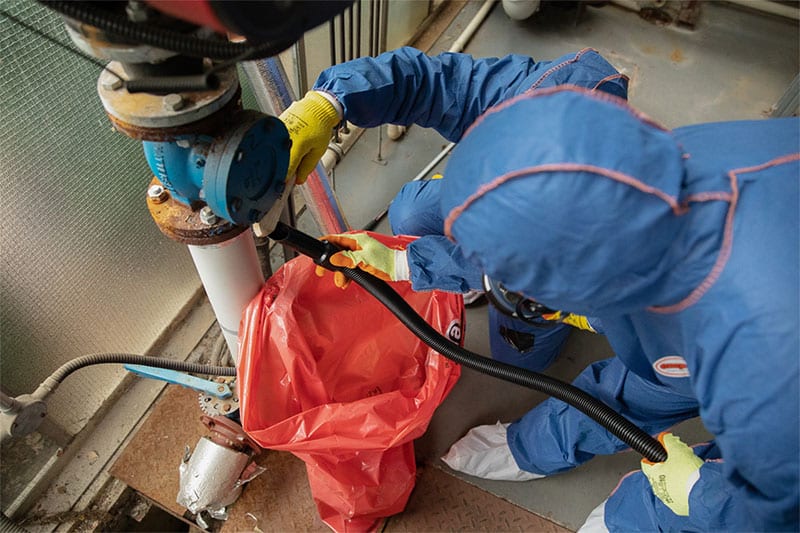Can I encapsulate asbestos instead of removing it?
When deciding the best way to manage asbestos on a property, the question of whether to encapsulate or remove the asbestos-containing material (ACM) comes up.
At times, the answer will be straightforward. An ACM that has obvious damage should be removed; an ACM in perfect condition can be encapsulated. Other times, though, the solution isn’t so obvious. This is when an experienced asbestos surveyor is helpful.
Overall, it’s important to know your options and what to take into consideration when making decisions about asbestos on your property. Proper management is the only way to ensure everyone will stay safe.

What is asbestos encapsulation?
Asbestos encapsulation is when the surface of an ACM is sealed to prevent asbestos fibres from escaping. There are a number of encapsulation methods, including painting the ACM by hand, spraying it, or covering it with non-ACMs.
While encapsulation will vary based on the ACM and the method chosen, here’s an example of the encapsulation method using paint:
- The surface of the ACM is pre-cleaned using an H-type vacuum cleaner to remove surface dust.
- Next, the surface of the ACM is treated with diluted PVA (a water-soluble synthetic polymer). The PVA is sprayed onto the surface to prepare it for being painted.
- The paint used for encapsulation is an elastomeric sealant, such as ET150. Two coats are applied.
Here’s another example: If the ACM is piping, then a calico wrap is first applied to the pipe. Next, the piping will be sealed with an elastomeric sealant, similar to this step in the above process.
What is asbestos removal?
Asbestos removal is when ACMs are safely removed from a building and properly disposed of. The method of removal and how dangerous a removal project is depends on the type of asbestos, the type of ACM, the ACM’s condition, and how likely it is that the ACM will be damaged during removal.
The process of removing asbestos is in-depth. It often includes the following steps:
- Planning the removal project and notifying the Health and Safety Executive (HSE).
- Discussing the project with anyone who will be affected.
- Constructing an airtight working area where removal will take place.
- Safely removing and disposing of the asbestos following proper containment procedures.
- Carefully cleaning the work area.
- Testing the work area to ensure the air is not contaminated with asbestos fibres.
That’s only a brief overview of what the process may include. Each step has several sub-steps that need to be taken as well.
When to encapsulate asbestos
The following situations may make encapsulation a suitable option:
- The ACMs are in good condition.
- The asbestos is in a low-risk area or an area with limited accessibility.
- The duty holder wants to preserve historical or valuable structures.
If it’s possible to leave the ACMs where they are without posing harm to those in the area, encapsulation may be the best option. Sometimes, it can be more dangerous to move the ACMs for disposal and risk damaging them during the process.
When to remove asbestos
The following situations are when asbestos removal is recommended:
- There are severely damaged or deteriorated ACMs.
- The ACMs are in high-risk areas or have a high potential for disturbance.
- The building is about to undergo a renovation or demolition project.
If the ACMs are currently damaged or have a high likelihood of being damaged, the best and safest option is to remove them.
Factors to consider
There are a number of factors to consider when deciding whether encapsulation or removal is the best option. Considerations include:
- The level of risk associated with the asbestos. If the ACMs are currently posing a problem because they’re damaged and are releasing or may release fibres, they should be removed.
- Regulatory requirements and local guidelines. For example, certain types of ACMs must be handled by a licensed contractor.
- Cost considerations for encapsulation versus removal. Encapsulation can cost a fraction of what removal costs.
None of these factors should be taken lightly. For example, even if a removal project will cost more than encapsulating the asbestos, it’s the necessary option if the ACMs are posing a health threat to workers or tenants.
How much does asbestos encapsulation cost?
Asbestos removal is an expensive endeavour, and encapsulation usually costs about 25% of the cost of removal. In our Asbestos Removal Cost Guide In The UK, we walk you through an example of the real costs of asbestos removal. Here’s a breakdown of how much our example project costs:
| Cost Associated Item: | Cost For This Project: | Guide To % of Cost: |
|---|---|---|
| 1) Cost: Overheads & Profit: | £3,485 | 27% |
| 2) Cost: Removal Team / Labour: | £4,800 | 37% |
| 3) Cost: Removal Materials: | £1,170 | 10% |
| 4) Cost: Removal Equipment: | £1,480 | 11% |
| 5) Cost: Removal Required Testing: | £495 | 4% |
| 6) Cost: Removal of Asbestos Waste: | £1,450 | 11% |
| TOTAL: | £12,880 | 100% |
In this case, the total for asbestos removal is £12,800. If encapsulation were a responsible alternative, the cost would be approximately £3,220.
Note that these figures are just examples of the cost of a removal project. It’s impossible to determine the cost of asbestos removal without assessing your specific situation.
Benefits and limitations of asbestos encapsulation
While encapsulation costs considerably less than removal and is an easier process overall, it’s not without its faults. Let’s go over the pros and cons of asbestos encapsulation.
Benefits of encapsulation
- Cost-effective when compared to removal
- Faster process than removal
- Minimal disruption to building occupants
- Potential preservation of original building features
- Renovation work on the building isn’t usually needed
Most importantly, encapsulation limits the risk of the ACM being damaged (which is more likely during removal) and releasing dangerous fibres into the air.
Limitations of encapsulation
- Long-term maintenance and monitoring requirements
- Potential for encapsulation product degradation over time
- Encapsulating damaged ACMs doesn’t remove the health risks
Benefits and process of asbestos removal
Asbestos removal is often the safer option, even if it’s the costlier one. In this section, we’ll discuss the benefits of asbestos removal and recap the process. We’ll also briefly go over the drawbacks of asbestos removal in some cases.
Benefits of asbestos removal
- Complete elimination of the asbestos hazard
- Compliance with regulations and safety standards
- Peace of mind for building occupants
Process of asbestos removal
- Hiring a licensed asbestos removal contractor
- Containment, removal, and disposal of ACMs following legal guidelines and best practices
Note that asbestos removal isn’t a pain-free option.
It can be expensive, especially when you consider that renovation work may be required for the removal to take place. It also carries a higher risk of damaging the ACMs during removal because the materials will be worked with directly.
Plus, because it takes longer than encapsulation, the building or part of the building won’t be usable during the removal project.
Importance of having a professional consultation
Unless you’re experienced in dealing with ACMs, you may not know by looking if the material poses a threat or not. It’s always best to have a professional asbestos consultant assess the property. They can tell you which ACMs should be encapsulated versus the ones that must be removed for safety reasons.
Your asbestos surveyor will conduct a thorough asbestos assessment and risk evaluation. They will provide recommendations that are tailored to your specific building and situation. From there, it’s the duty holder’s responsibility to decide how to proceed.
Final thoughts about encapsulating versus removing asbestos
Asbestos encapsulation and removal are two options for dealing with ACMs in a building.
- Encapsulation is when the ACM’s surface is sealed off so that fibres can’t escape. This may be done with paint, spray coatings, or other non-asbestos materials.
- Removal is when the ACM is safely removed from the building and disposed of, and then the area is decontaminated so that it’s safe for occupancy.
Whichever option you think is best, it’s always wise to consult with an asbestos expert for proper guidance. Sometimes, what seems like an encapsulation project is actually a removal project if the ACM is more damaged than you realise. Other times, encapsulation is the safer decision if the ACM doesn’t pose an immediate threat.
Whether you decide that encapsulation or removal is necessary, your top priority should be the health and safety of the building’s occupants and workers.

Written by Callum McDonald
Callum McDonald is an expert in asbestos quality management, ensuring rigorous adherence to regulations and high-quality standards in removal projects. His focus on enhancing quality and client satisfaction makes him a crucial asset in safety and compliance within the field. Callum's expertise in technical support and oversight of licensed works underscores his commitment to excellence in asbestos management, providing invaluable guidance to clients in this specialised area.
